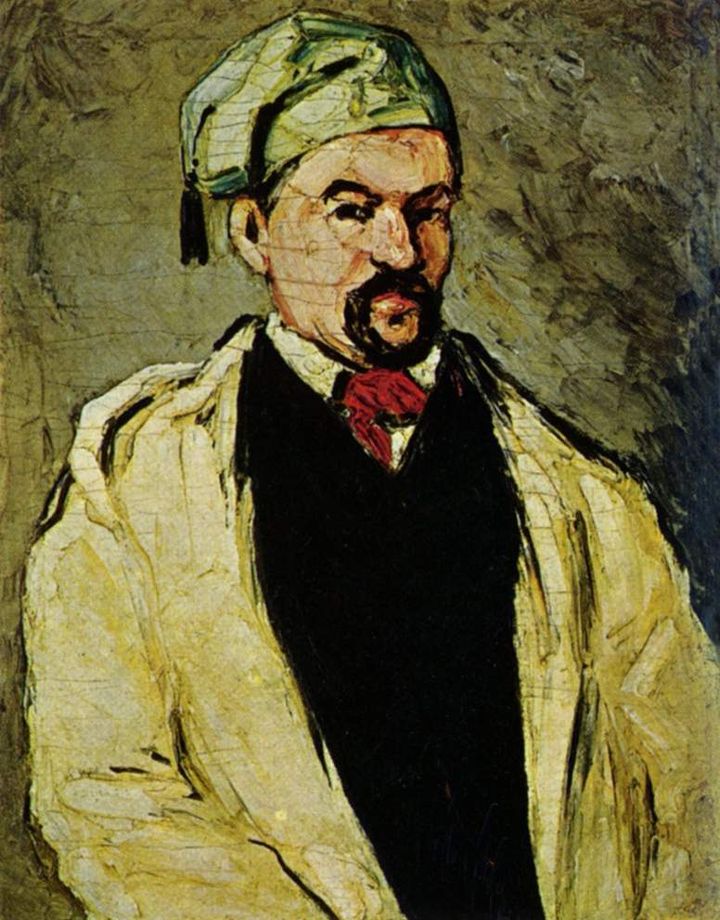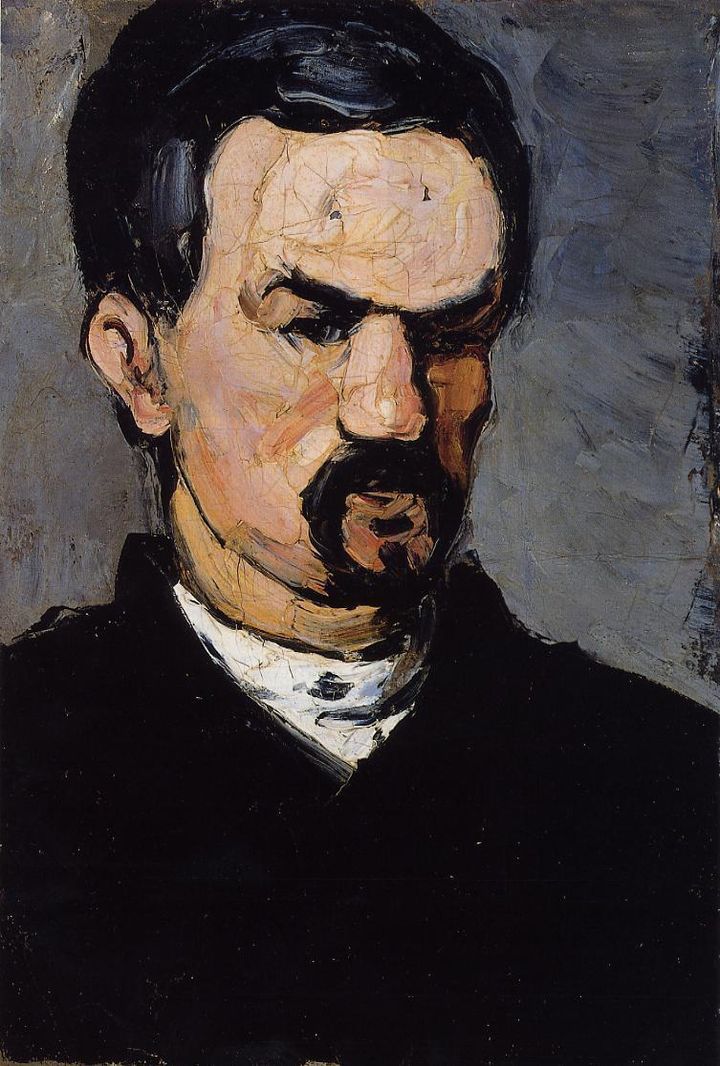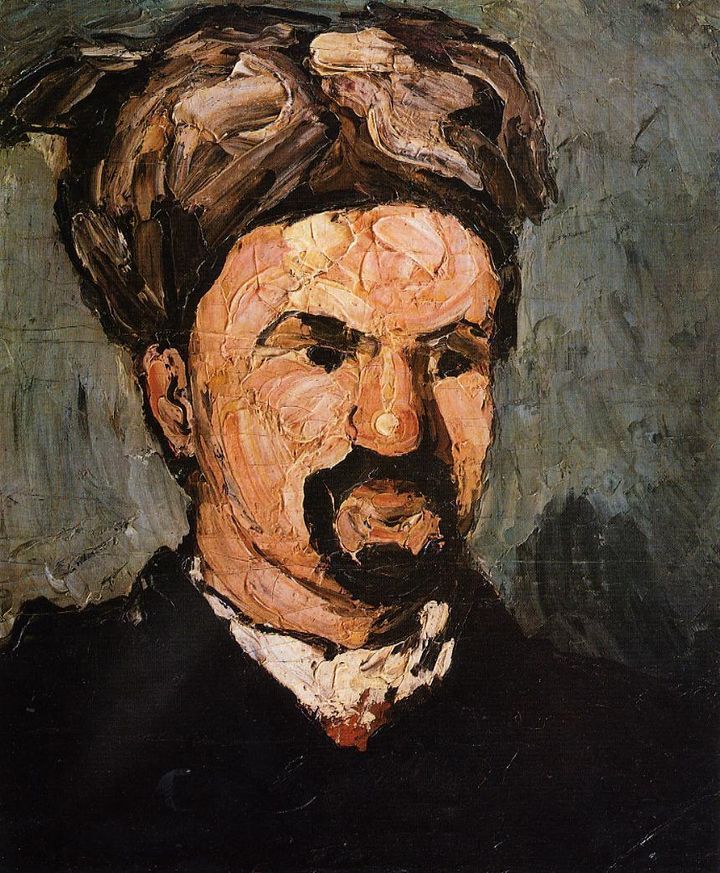Paul Cézanne painted his uncle Dominique Aubert at least 9 times in 1866, when the artist was 27 years old. These portraits, four of which are in the current exhibition of Cézanne portraits at London's National Portrait Gallery, are not recognizable as works by Cézanne –which is to say that they look nothing like the mature paintings we think of as Cézannes. These early portraits were painted predominantly in black and white, with heavily encrusted paint slathered on with a palette knife (think Chaim Soutine, or late Lucian Freud). And they are all different: Dominique wears a hat in some, not in others; different clothes; his expressions are different; even the sizes of the paintings are different. Cézanne’s motive for painting his uncle so frequently is not known, but this was clearly not an exercise in replication.

“Portrait of a Man in a Blue Cap (Uncle Dominique),” by Paul Cézanne (1866).
What these paintings demonstrate is that for Cézanne, even before he had worked with Pissarro and learned the multiple lessons of Impressionism, painting involved repetition with experimentation. Even before Pissarro opened his eyes to nature and he found his true subject, Cézanne was by temperament an experimental artist, who worked by trial and error. His uncle was evidently among the first of his subjects who learned this at the expense of their own time (Ambroise Vollard later reported that he sat through 115 sessions for a portrait Cézanne considered unfinished).

“Portrait of Uncle Dominique,” by Paul Cézanne (1866).
Cézanne would later become a master of color, and would invent new methods of representing space, but all of his discoveries would emerge and develop within this same framework of trial-and-error experimentation. Looking at this selection of works made throughout his career brings home forcefully the point that for him art was less about products than about process. No painting was ever truly finished, because the quest for the vague and elusive visual resolution he called realization was never final. Roger Fry’s study of Cézanne led him to conclude that “for him the synthesis was an asymptote toward which he was forever approaching without ever quite reaching it; it was a reality, incapable of complete realization.” In fact, however, Cézanne seems to have come to recognize that realization was not an asymptote – it was not a fixed goal he could approach, but rather a moving target that receded from him faster than he could progress toward it.
Paradoxically, he discovered that his task became more difficult as he became more skillful. A month before his death he reported to his son that “I am becoming more clear-sighted before nature,” then continued, “but the realization of my senses is always painful. I cannot attain the intensity that is unfolded before my senses, I have not the magnificent richness of coloring that animates nature.” As he grew older, his constant application made his vision more acute, allowing him to distinguish ever smaller gradations of color and form in nature, but this made it ever more difficult to create the precise colors on his palette, and to make the necessary marks with his brush, that would accurately render his perception of the object he was portraying.

“Portrait of Uncle Dominique in Profile,” by Paul Cézanne (1866).
In The Unknown Masterpiece, published in 1837, Balzac created the fictional master Frenhofer, who had spent a lifetime pursuing an evasive artistic ideal of beauty. An admirer of Frenhofer recognized his predicament, describing him as “a man who sees higher and farther than other painters,” but who “by dint of so much research…has come to doubt the very object of his investigations.” Cézanne famously identified with Frenhofer. Emile Bernard described a conversation at dinner during Bernard’s visit to Aix in 1904:
One evening I spoke to him of The Unknown Masterpiece, and of Frenhofer, the hero of Balzac’s tragedy. He got up from the table, stood before me, and striking his chest with his index finger, he admitted wordlessly by this repeated gesture that he was the very character in the novel. He was so moved by the feeling that tears filled his eyes. Someone who had lived earlier, but whose soul was prophetical, had understood him.

“Portrait of Uncle Dominique in a Turban,” by Paul Cézanne (1866).
In the abrupt ending of Balzac's novella, Frenhofer killed himself, after burning his canvases, in frustration at his inability to achieve his impossible goal. Cézanne felt this same frustration, but he did not yield to it, and he fulfilled his vow to die painting. Though he could never satisfy his lofty ambitions, his late work directly influenced every important artistic development of the next generation, and today remains a monument to the true beginning of modern art. His career demonstrates not only that the perfect is the enemy of the good, but that it can be the enemy of the great. The impossibility of Cézanne’s dream should not blind us to the fact that his art, and life, were in fact a triumph.
